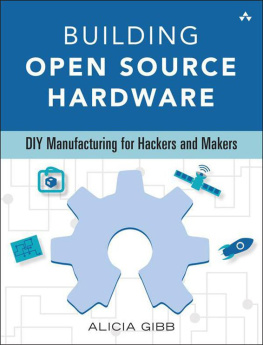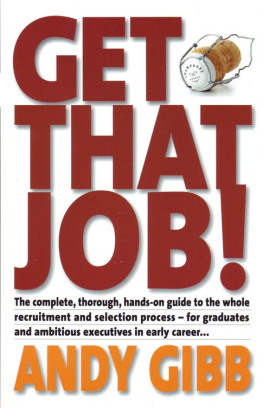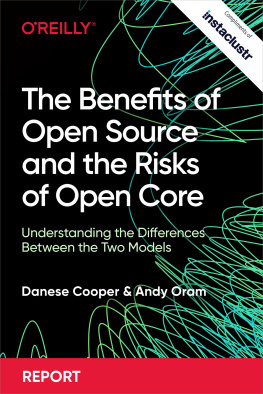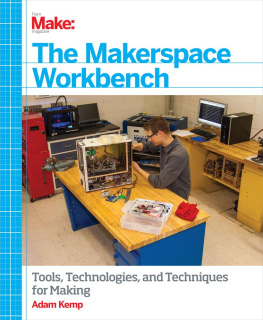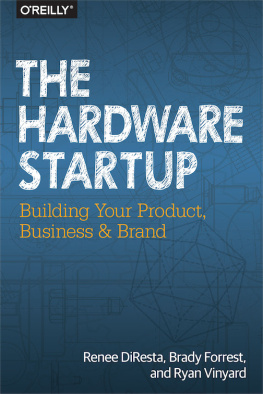Gibb - Building Open Source Hardware: DIY Manufacturing for Hackers and Makers
Here you can read online Gibb - Building Open Source Hardware: DIY Manufacturing for Hackers and Makers full text of the book (entire story) in english for free. Download pdf and epub, get meaning, cover and reviews about this ebook. City: Boston, year: 2014, publisher: Addison-Wesley Professional, genre: Computer. Description of the work, (preface) as well as reviews are available. Best literature library LitArk.com created for fans of good reading and offers a wide selection of genres:
Romance novel
Science fiction
Adventure
Detective
Science
History
Home and family
Prose
Art
Politics
Computer
Non-fiction
Religion
Business
Children
Humor
Choose a favorite category and find really read worthwhile books. Enjoy immersion in the world of imagination, feel the emotions of the characters or learn something new for yourself, make an fascinating discovery.
Building Open Source Hardware: DIY Manufacturing for Hackers and Makers: summary, description and annotation
We offer to read an annotation, description, summary or preface (depends on what the author of the book "Building Open Source Hardware: DIY Manufacturing for Hackers and Makers" wrote himself). If you haven't found the necessary information about the book — write in the comments, we will try to find it.
Gibb: author's other books
Who wrote Building Open Source Hardware: DIY Manufacturing for Hackers and Makers? Find out the surname, the name of the author of the book and a list of all author's works by series.
Building Open Source Hardware: DIY Manufacturing for Hackers and Makers — read online for free the complete book (whole text) full work
Below is the text of the book, divided by pages. System saving the place of the last page read, allows you to conveniently read the book "Building Open Source Hardware: DIY Manufacturing for Hackers and Makers" online for free, without having to search again every time where you left off. Put a bookmark, and you can go to the page where you finished reading at any time.
Font size:
Interval:
Bookmark:
ePUB is an open, industry-standard format for eBooks. However, support of ePUB and its many features varies across reading devices and applications. Use your device or app settings to customize the presentation to your liking. Settings that you can customize often include font, font size, single or double column, landscape or portrait mode, and figures that you can click or tap to enlarge. For additional information about the settings and features on your reading device or app, visit the device manufacturers Web site.
Many titles include programming code or configuration examples. To optimize the presentation of these elements, view the eBook in single-column, landscape mode and adjust the font size to the smallest setting. In addition to presenting code and configurations in the reflowable text format, we have included images of the code that mimic the presentation found in the print book; therefore, where the reflowable format may compromise the presentation of the code listing, you will see a Click here to view code image link. Click the link to view the print-fidelity code image. To return to the previous page viewed, click the Back button on your device or app.
DIY Manufacturing for Hackers and Makers
Alicia Gibb
with
Steven Abadie
Ed Baafi
Matt Bolton
Kipp Bradford
Gabriella Levine
David A. Mellis
Catarina Mota
Joshua Pearce
Becky Stern
Tiffany Tseng
Addie Wagenknecht
Michael Weinberg
Amanda Wozniak
Lars Zimmerman

Upper Saddle River, NJ Boston Indianapolis San Francisco
New York Toronto Montreal London Munich Paris Madrid
Capetown Sydney Tokyo Singapore Mexico City
Many of the designations used by manufacturers and sellers to distinguish their products are claimed as trademarks. Where those designations appear in this book, and the publisher was aware of a trademark claim, the designations have been printed with initial capital letters or in all capitals.
The authors and publisher have taken care in the preparation of this book, but make no expressed or implied warranty of any kind and assume no responsibility for errors or omissions. No liability is assumed for incidental or consequential damages in connection with or arising out of the use of the information or programs contained herein.
For information about buying this title in bulk quantities, or for special sales opportunities (which may include electronic versions; custom cover designs; and content particular to your business, training goals, marketing focus, or branding interests), please contact our corporate sales department at or (800) 382-3419.
For government sales inquiries, please contact .
For questions about sales outside the U.S., please contact .
Visit us on the Web: informit.com/aw
Library of Congress Control Number: 2014952506
Copyright 2015 Pearson Education, Inc.
All rights reserved. Printed in the United States of America. This publication is protected by copyright, and permission must be obtained from the publisher prior to any prohibited reproduction, storage in a retrieval system, or transmission in any form or by any means, electronic, mechanical, photocopying, recording, or likewise. To obtain permission to use material from this work, please submit a written request to Pearson Education, Inc., Permissions Department, One Lake Street, Upper Saddle River, New Jersey 07458, or you may fax your request to (201) 236-3290.
.
All rights to the anecdotes, appendixes, and are held by the authors.
ISBN-13: 978-0-321-90604-5
ISBN-10: 0-321-90604-7
Text printed in the United States on recycled paper at RR Donnelley in Crawfordsville, Indiana. First printing, December 2014

Dedicated to Aaron Swartz, a friend, a mentor,
and the greatest teacher of open source.
Building Open Source Hardware is an anthology written to get users and makers of open source hardware to the next step of developing for the masses and manufacturing. This book involves a handson approach, providing guides for developing and manufacturing open source hardware. Although many books have been published on specific pieces of open source hardware, to date there has not been a book published on the community or the steps to work all the way through designing and manufacturing a piece of open source hardware. There has been a burst of activity around making and doityourself (DIY) projects, but the DIY and maker movements are growing to a new stage, wanting to produce on larger scales and move projects to products. If you have been hacking on some hardware in your basement and want to start building multiples of it and selling them on your website as open source, this book is for you.
This book covers both the theoretical side of open source hardware and the practices and methods necessary to create a piece of open source hardware. It is intended to be a holistic experience, moving from developing to manufacturing of open source hardware, while explaining the benefits, standards, and incentives found at the various stages of this process. This book includes beginner to intermediatelevel technical concepts and is coupled with an open source hardware kit that can be purchased separately to foster experimentation.
The intended audience of this book includes people from a multitude of fields, all of whom are interested in creating open source hardware and would like a guide for the theory, standards, and handson advice. Individuals and companies, large and small, that are already interested in the DIY and maker movement, but still need some help on how to create, document, and think about licensing, manufacturing, and selling open source hardware will also benefit from this book.
I chose not to selfpublish for a number of reasons. The major one, however, was that without a publisher inviting me to write a book on this topic, the thought would have never occurred to me. My publisher is also well known in the open source software community for publishing portions of books with open source licenses, so this book is partially open source, too! The chapters written under a Creative Commons license are listed on the copyright page.
Open source hardwaresometimes abbreviated OSH or OSHWis hardware whose source files are publicly available for anyone to use, remanufacture, redesign, and resell. The open source hardware movement, similar to the DIY and maker movement, is not a new concept, but rather is a revitalization of historical methods that were displaced as modern manufacturing came to the fore. Modern manufacturing produces hardware cheaply and efficiently (albeit stifled with legal boundaries) and, as a result, has created a consumer culture, rather than a DIY culture. In the past 10 years, the pendulum has begun to swing back in favor of creating and fixing things rather than buying them.
Open source hardware values sharing, transparency, and accepting predecessors and successors to your work, both in the form of a company that might build something off your hardware and a project that might copy part or all of your hardware design. Transparency in hardware is becoming increasingly important as technologies become more opaque as their size dwindles, making it more difficult to discover with the naked eye how they work. As more complexities are added, the design also gets harder to discern. Open source hardware, in contrast, offers freedom of information in a physical format. Freedom of information for hardware means that the source files are accessible and easily available to rebuild the object. Source files may include schematics, diagrams, code, and assembly instructions, to name a few options.
Font size:
Interval:
Bookmark:
Similar books «Building Open Source Hardware: DIY Manufacturing for Hackers and Makers»
Look at similar books to Building Open Source Hardware: DIY Manufacturing for Hackers and Makers. We have selected literature similar in name and meaning in the hope of providing readers with more options to find new, interesting, not yet read works.
Discussion, reviews of the book Building Open Source Hardware: DIY Manufacturing for Hackers and Makers and just readers' own opinions. Leave your comments, write what you think about the work, its meaning or the main characters. Specify what exactly you liked and what you didn't like, and why you think so.

